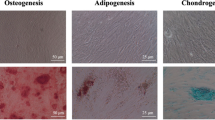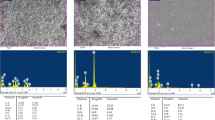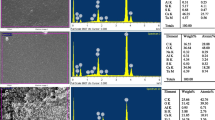Abstract
Objective
The aim of this study was to analyze the biological effects of MTA Repair HP and ProRoot MTA on human periodontal ligament stem cells (hPDLSCs) after exposure to acidic and neutral environments.
Materials and methods
Discs of each material (n = 30) were exposed to phosphate buffered saline (pH = 7.4) or butyric acid (pH = 5.2) for 7 days, and biological testing was carried out in vitro on hPDLSCs. Cell viability and apoptosis assays were performed using eluates of each root-end filling material. To evaluate cell attachment to the different materials, hPDLSCs were directly seeded onto the material surfaces and analyzed by scanning electron microscopy. The chemical composition of the root-end filling materials was determined by energy-dispersive x-ray and eluates were analyzed by inductively coupled plasma-mass spectrometry. Statistical differences were assessed by ANOVA and Tukey test (p < 0.05).
Results
Under an acidic environment, both materials displayed similar ion release abilities, with the increased release of Si and Ca ions. Substantial changes in microstructure were observed for both materials after exposure to acidic pH. In addition, material exposure to an acidic environment showed a similar degree of cell adherence, and, surprisingly, MTA Repair HP exhibited higher cell viability rates at pH 5.2 than ProRoot MTA.
Conclusions
Exposure to an acidic environment promoted Si and Ca ion release from ProRoot MTA and MTA Repair HP. Moreover, we observed optimal biological properties of ProRoot MTA and MTA Repair HP in terms of cell viability, cell death, and cell attachment in both environments.
Clinical relevance
These results may suggest that MTA Repair HP and ProRoot exhibited optimal biological properties in terms of cell viability, cell death and cell attachment in acidic environment, being considered as materials for root-end filling and perforations.



Similar content being viewed by others
References
Alsulaimani RS (2018) Immediate and delayed repair of 2 sizes of furcal perforations in dogs’ teeth using mineral trioxide aggregate cement. J Endod 44:1000–1006. https://doi.org/10.1016/j.joen.2018.02.026
Torabinejad M, Parirokh M, Dummer PMH (2018) Mineral trioxide aggregate and other bioactive endodontic cements: an updated overview—part II: other clinical applications and complications. Int Endod J 51(3):284–317. https://doi.org/10.1111/iej.12843
Tomas-Catala CJ, Collado-Gonzalez M, Garcia-Bernal D, Onate-Sanchez RE, Forner L, Llena C, Lozano A, Moraleda JM, Rodriguez-Lozano FJ (2018) Biocompatibility of new pulp-capping materials NeoMTA Plus, MTA Repair HP, and Biodentine on human dental pulp stem cells. J Endod 44(1):126–132. https://doi.org/10.1016/j.joen.2017.07.017
Camilleri J (2007) Hydration mechanisms of mineral trioxide aggregate. Int Endod J 40(6):462–470. https://doi.org/10.1111/j.1365-2591.2007.01248.x
Camilleri J (2015) Staining potential of Neo MTA Plus, MTA Plus, and Biodentine used for pulpotomy procedures. J Endod 41(7):1139–1145. https://doi.org/10.1016/j.joen.2015.02.032
Gandolfi MG, Siboni F, Botero T, Bossu M, Riccitiello F, Prati C (2015) Calcium silicate and calcium hydroxide materials for pulp capping: biointeractivity, porosity, solubility and bioactivity of current formulations. J Appl Biomater Funct Mater 13(1):43–60. https://doi.org/10.5301/jabfm.5000201
Natu VP, Dubey N, Loke GC, Tan TS, Ng WH, Yong CW, Cao T, Rosa V (2015) Bioactivity, physical and chemical properties of MTA mixed with propylene glycol. J Appl Oral Sci 23(4):405–411. https://doi.org/10.1590/1678-775720150084
Prati C, Gandolfi MG (2015) Calcium silicate bioactive cements: biological perspectives and clinical applications. Dent Mater 31(4):351–370. https://doi.org/10.1016/j.dental.2015.01.004
Dubey N, Rajan SS, Bello YD, Min KS, Rosa V (2017) Graphene nanosheets to improve physico-mechanical properties of bioactive calcium silicate cements. Materials (Basel) 10(6):606. https://doi.org/10.3390/ma10060606
Sultana N, Singh M, Nawal RR, Chaudhry S, Yadav S, Mohanty S, Talwar S (2018) Evaluation of biocompatibility and osteogenic potential of tricalcium silicate-based cements using human bone marrow-derived mesenchymal stem cells. J Endod 44(3):446–451. https://doi.org/10.1016/j.joen.2017.11.016
Bortoluzzi EA, Niu LN, Palani CD, El-Awady AR, Hammond BD, Pei DD, Tian FC, Cutler CW, Pashley DH, Tay FR (2015) Cytotoxicity and osteogenic potential of silicate calcium cements as potential protective materials for pulpal revascularization. Dent Mater 31(12):1510–1522. https://doi.org/10.1016/j.dental.2015.09.020
Agrafioti A, Taraslia V, Chrepa V, Lymperi S, Panopoulos P, Anastasiadou E, Kontakiotis EG (2016) Interaction of dental pulp stem cells with Biodentine and MTA after exposure to different environments. J Appl Oral Sci 24(5):481–486. https://doi.org/10.1590/1678-775720160099
Tian J, Zhang Y, Lai Z, Li M, Huang Y, Jiang H, Wei X (2017) Ion release, microstructural, and biological properties of iRoot BP plus and ProRoot MTA exposed to an acidic environment. J Endod 43(1):163–168. https://doi.org/10.1016/j.joen.2016.10.011
Agrafioti A, Tzimpoulas N, Chatzitheodoridis E, Kontakiotis EG (2016) Comparative evaluation of sealing ability and microstructure of MTA and biodentine after exposure to different environments. Clin Oral Investig 20(7):1535–1540. https://doi.org/10.1007/s00784-015-1638-6
Akhavan H, Mohebbi P, Firouzi A, Noroozi M (2016) X-ray diffraction analysis of ProRoot mineral trioxide aggregate hydrated at different pH values. Iran Endod J 11(2):111–113. https://doi.org/10.7508/iej.2016.02.007
Tomas-Catala CJ, Collado-Gonzalez M, Garcia-Bernal D, Onate-Sanchez RE, Forner L, Llena C, Lozano A, Castelo-Baz P, Moraleda JM, Rodriguez-Lozano FJ (2017) Comparative analysis of the biological effects of the endodontic bioactive cements MTA-angelus, MTA repair HP and NeoMTA plus on human dental pulp stem cells. Int Endod J 50(Suppl 2):e63–e72. https://doi.org/10.1111/iej.12859
Silva E, Carvalho NK, Guberman M, Prado M, Senna PM, Souza EM, De-Deus G (2017) Push-out bond strength of fast-setting mineral trioxide aggregate and Pozzolan-based cements: ENDOCEM MTA and ENDOCEM Zr. J Endod 43(5):801–804. https://doi.org/10.1016/j.joen.2016.12.007
Silva EJ, Carvalho NK, Zanon M, Senna PM, DE-Deus, G, Zuolo ML, Zaia AA (2016) Push-out bond strength of MTA HP, a new high-plasticity calcium silicate-based cement. Braz Oral Res 30(1):S1806-83242016000100269. https://doi.org/10.1590/1807-3107BOR-2016.vol30.0084
Duarte MA, Alves de Aguiar K, Zeferino MA, Vivan RR, Ordinola-Zapata R, Tanomaru-Filho M, Weckwerth PH, Kuga MC (2012) Evaluation of the propylene glycol association on some physical and chemical properties of mineral trioxide aggregate. Int Endod J 45(6):565–570
Gomes Cornelio AL, Salles LP, Campos da Paz M, Cirelli JA, Guerreiro-Tanomaru JM, Tanomaru Filho M (2011) Cytotoxicity of Portland cement with different radiopacifying agents: a cell death study. J Endod 37(2):203–210. https://doi.org/10.1016/j.joen.2010.11.017
Rodriguez-Lozano FJ, Garcia-Bernal D, Onate-Sanchez RE, Ortolani-Seltenerich PS, Forner L, Moraleda JM (2017) Evaluation of cytocompatibility of calcium silicate-based endodontic sealers and their effects on the biological responses of mesenchymal dental stem cells. Int Endod J 50(1):67–76. https://doi.org/10.1111/iej.12596
Vera-Sánchez M, Aznar-Cervantes S, Jover E, García-Bernal D, Oñate-Sánchez RE, Hernández-Romero D, Moraleda JM, Collado-González M, Rodríguez-Lozano FJ, Cenis JL (2016) Silk-fibroin and graphene oxide composites promote human periodontal ligament stem cell spontaneous differentiation into osteo/cementoblast-like cells. Stem Cells Dev 25(22):1742–1754. https://doi.org/10.1089/scd.2016.0028
Akbulut MB, Uyar Arpaci P, Unverdi Eldeniz A (2016) Effects of novel root repair materials on attachment and morphological behaviour of periodontal ligament fibroblasts: scanning electron microscopy observation. Microsc Res Tech 79(12):1214–1221. https://doi.org/10.1002/jemt.22780
Küçükkaya S, Görduysus M, Zeybek ND, Müftüoğlu SF (2016) In vitro cytotoxicity of calcium silicate-based endodontic cement as root-end filling materials. Scientifica (Cairo) 2016(9203932):1–5. https://doi.org/10.1155/2016/9203932
Collado-Gonzalez M, Garcia-Bernal D, Onate-Sanchez RE, Ortolani-Seltenerich PS, Lozano A, Forner L, Llena C, Rodriguez-Lozano FJ (2017) Biocompatibility of three new calcium silicate-based endodontic sealers on human periodontal ligament stem cells. Int Endod J 50(9):875–884. https://doi.org/10.1111/iej.12703
Dominici M, Le Blanc K, Mueller I, Slaper-Cortenbach I, Marini F, Krause D, Deans R, Keating A, Prockop D, Horwitz E (2006) Minimal criteria for defining multipotent mesenchymal stromal cells. The International Society for Cellular Therapy position statement. Cytotherapy 8(4):315–317. https://doi.org/10.1080/14653240600855905
Wang Y, Zhou Y, Jin L, Pang X, Lu Y, Wang Z, Yu Y, Yu J (2018) Mineral trioxide aggregate enhances the osteogenic capacity of periodontal ligament stem cells via NF-kappaB and MAPK signaling pathways. J Cell Physiol 233(3):2386–2397. https://doi.org/10.1002/jcp.26110
Bueno C, Ramirez C, Rodríguez-Lozano FJ, Tabarés-Seisdedos R, Rodenas M, Moraleda JM, Jones JR, Martinez S (2013) Human adult periodontal ligament-derived cells integrate and differentiate after implantation into the adult mammalian brain. Cell Transplant 22(11):2017–2028. https://doi.org/10.3727/096368912X657305
Namazikhah MS, Nekoofar MH, Sheykhrezae MS, Salariyeh S, Hayes SJ, Bryant ST, Mohammadi MM, Dummer PM (2008) The effect of pH on surface hardness and microstructure of mineral trioxide aggregate. Int Endod J 41(2):108–116. https://doi.org/10.1111/j.1365-2591.2007.01325.x
Rajasekharan S, Vercruysse C, Martens L, Verbeeck R (2018) Effect of exposed surface area, volume and environmental pH on the calcium ion release of three commercially available tricalcium silicate based dental cements. Materials (Basel) 11(1):123. https://doi.org/10.3390/ma11010123
Yamamoto S, Han L, Noiri Y, Okiji T (2016) Evaluation of the Ca ion release, pH and surface apatite formation of a prototype tricalcium silicate cement. Int Endod J 50:e73–e82. https://doi.org/10.1111/iej.12737
Chen S, Shi L, Luo J, Engqvist H (2018) A novel fast-setting mineral trioxide aggregate: its formulation, chemical-physical properties and cytocompatibility. ACS Appl Mater Interfaces 10:20334–20341. https://doi.org/10.1021/acsami.8b04946
Zamparini F, Siboni F, Prati C, Taddei P, Gandolfi MG (2018) Properties of calcium silicate-monobasic calcium phosphate materials for endodontics containing tantalum pentoxide and zirconium oxide. Clin Oral Investig 23:445–457. https://doi.org/10.1007/s00784-018-2453-7
Chen I, Karabucak B, Wang C, Wang HG, Koyama E, Kohli MR, Nah HD, Kim S (2015) Healing after root-end microsurgery by using mineral trioxide aggregate and a new calcium silicate-based bioceramic material as root-end filling materials in dogs. J Endod 41(3):389–399. https://doi.org/10.1016/j.joen.2014.11.005
Ahmed HM, Luddin N, Kannan TP, Mokhtar KI, Ahmad A (2014) Cell attachment properties of Portland cement-based endodontic materials: biological and methodological considerations. J Endod 40(10):1517–1523. https://doi.org/10.1016/j.joen.2014.06.013
Ashofteh Yazdi K, Ghabraei S, Bolhari B, Kafili M, Meraji N, Nekoofar MH, Dummer PMH (2018) Microstructure and chemical analysis of four calcium silicate-based cements in different environmental conditions. Clin Oral Investig 23:43–52. https://doi.org/10.1007/s00784-018-2394-1
Ahmed HMA, Luddin N, Kannan TP, Mokhtar KI, Ahmad A (2017) White mineral trioxide aggregate mixed with calcium chloride dihydrate: chemical analysis and biological properties. Restor Dent Endod 42(3):176–187. https://doi.org/10.5395/rde.2017.42.3.176
Camilleri J, Formosa L, Damidot D (2013) The setting characteristics of MTA plus in different environmental conditions. Int Endod J 46(9):831–840. https://doi.org/10.1111/iej.12068
Guimaraes BM, Prati C, Duarte MAH, Bramante CM, Gandolfi MG (2018) Physicochemical properties of calcium silicate-based formulations MTA Repair HP and MTA Vitalcem. J Appl Oral Sci 26:e2017115. https://doi.org/10.1590/1678-7757-2017-0115
Cintra LTA, Benetti F, de Azevedo Queiroz IO, de Araujo Lopes JM, Penha de Oliveira SH, Sivieri Araujo G, Gomes-Filho JE (2017) Cytotoxicity, biocompatibility, and biomineralization of the new high-plasticity MTA material. J Endod 43(5):774–778. https://doi.org/10.1016/j.joen.2016.12.018
Funding
This work was supported by the Spanish Network of Cell Therapy (TerCel), RETICS subprograms of the I+D+I 2013–2016 Spanish National Plan, and projects “RD12/0019/0001” and “RD16/0011/0001” funded by the Instituto de Salud Carlos III to JMM and co-funded by the European Regional Development Fund.
Author information
Authors and Affiliations
Corresponding author
Ethics declarations
Conflicts of interest
The authors declare that they have no competing interests.
Ethical approval
All procedures performed in studies involving human participants were in accordance with the ethical standards of the institutional and/or national research committee and with the 1964 Helsinki Declaration and its later amendments or comparable ethical standards. The study protocol was approved by the Clinical Research Ethics Committee of the University of Murcia (procedure number: 1528/2017). Likewise, permission was obtained from the Health Department authorities to use the information contained in the CDHs, previously anonymized by one of the investigators belonging to the medical staff of the Health Department in order to protect patient confidentiality. All the information was processed in abidance with the confidentiality regulations defined under Act 15/1999 referred to personal data protection.
Informed consent
Informed consent was obtained from the parents of all individual participants included in the study.
Additional information
Publisher’s note
Springer Nature remains neutral with regard to jurisdictional claims in published maps and institutional affiliations.
Rights and permissions
About this article
Cite this article
Collado-González, M., López-García, S., García-Bernal, D. et al. Biological effects of acid-eroded MTA Repair HP and ProRoot MTA on human periodontal ligament stem cells. Clin Oral Invest 23, 3915–3924 (2019). https://doi.org/10.1007/s00784-019-02822-2
Received:
Accepted:
Published:
Issue Date:
DOI: https://doi.org/10.1007/s00784-019-02822-2




